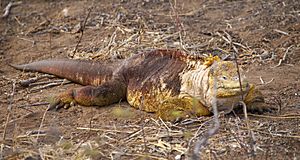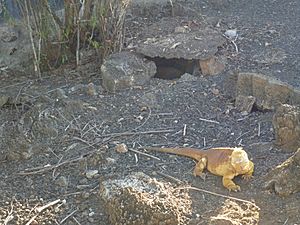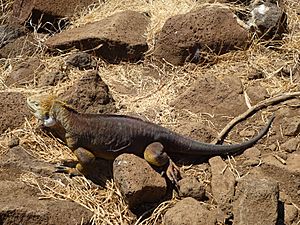Galapagos land iguana facts for kids
Quick facts for kids Galápagos land iguana |
|
|---|---|
 |
|
| Conservation status | |
| Scientific classification | |
| Genus: |
Conolophus
|
| Species: |
subcristatus
|
The Galápagos land iguana is a very large lizard that lives on the Galápagos Islands. Its scientific name is Conolophus subcristatus. These amazing creatures are unique to these islands.
Contents
About the Galápagos Land Iguana
Galápagos land iguanas can grow quite big. They reach a length of about 1 to 1.5 meters (3 to 5 feet). They can weigh up to 13 kilograms (29 pounds). Their size depends on which island they come from.
These iguanas are cold-blooded. This means they get their body heat from outside sources. They love to warm up by basking in the sun on volcanic rock. At night, they sleep in burrows. This helps them keep warm.
Land iguanas also have a special friendship with birds. Birds help them by removing parasites and ticks from their skin. This is a great deal for both animals! The iguanas get relief, and the birds get a meal.
What Galápagos Land Iguanas Eat
Galápagos land iguanas mostly eat plants. This means they are herbivores. However, some iguanas also eat insects, centipedes, and even dead animals.
Fresh water is hard to find on the islands where they live. So, the iguanas get most of their water from the prickly-pear cactus. This cactus makes up about 80% of their diet! They eat all parts of the plant. This includes the fruit, flowers, pads, and even the spines. When it rains, they drink from puddles. They also enjoy eating yellow flowers from the Portulaca plant.
Life Span of the Galápagos Land Iguana
The Galápagos land iguana can live for a very long time. They typically live between 60 and 69 years.
Reproduction and Life Cycle
Galápagos land iguanas become old enough to have babies when they are between eight and fifteen years old. The exact age depends on their island home. The mating season also changes from island to island.
After mating, female iguanas travel to sandy areas. They dig a burrow about 50 centimeters (20 inches) deep. There, they lay 2 to 20 eggs. The eggs usually hatch after 90 to 125 days.
Helping the Galápagos Land Iguana Population
The Galápagos land iguana disappeared from Baltra Island by 1954. It is believed that soldiers on the island hunted them for fun. However, in the 1930s, a man named William Randolph Hearst moved some iguanas from Baltra to North Seymour Island. This island is a short distance north of Baltra. He moved them because he wondered why no iguanas lived there naturally.
Hearst's iguanas survived and had babies. These iguanas became important for a special program. The Charles Darwin Research Station started a program to breed iguanas in captivity. This program has successfully brought the species back to Baltra and other areas. Today, visitors often see iguanas near the Baltra airport runway or crossing the roads.
Cool Facts About the Galápagos Land Iguana
- The Galápagos land iguana is one of the biggest lizards in the world.
- Charles Darwin once called them "ugly animals." He also said they had a "stupid appearance."
- Long ago, there were so many land iguanas on Santiago Island. Charles Darwin wrote that they could barely find a spot to set up their tent because of all the iguana burrows!
- Right now, there are about 5,000 to 10,000 Galápagos land iguanas.
- Scientists think that Galápagos land iguanas and marine iguanas came from the same ancestor. This ancestor arrived on the islands from South America.
- On South Plaza Island, land iguanas and marine iguanas sometimes have babies together. This happens where their homes overlap. The babies are called hybrid iguanas. They have features from both types of iguanas.
Other Types of Galápagos Land Iguanas
Besides the well-known Galápagos land iguana (C. subcristatus), there are two other species. These are the Galápagos pink land iguana (C. marthae), found on northern Isabela Island. The other is the Santa Fe land iguana (C. pallidus), which lives on Santa Fe Island.
See also
 In Spanish: Iguana terrestre de las Galápagos para niños
In Spanish: Iguana terrestre de las Galápagos para niños








